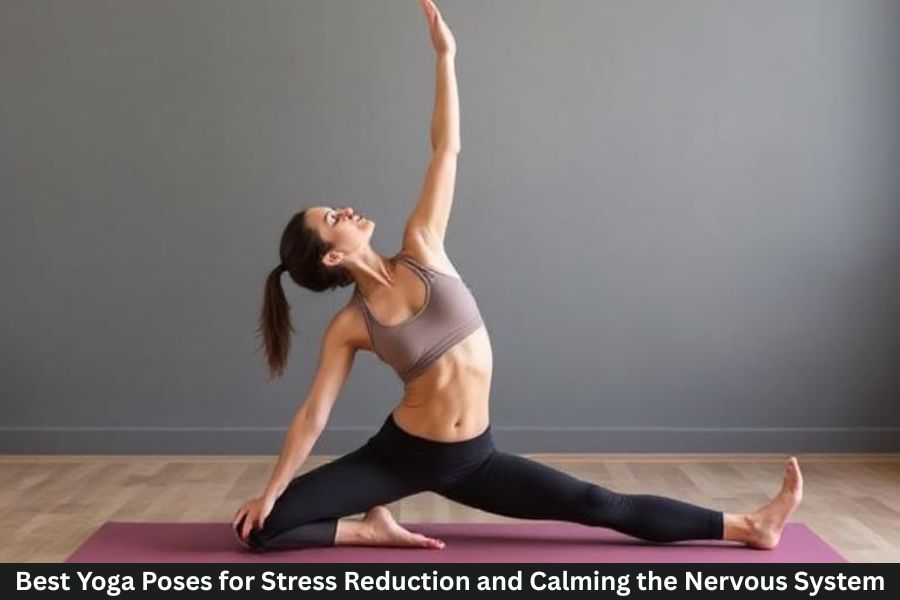Stress flips your body into fight-or-flight: heart rate and cortisol rise, breath shifts high and shallow, muscles brace. Helpful in short bursts, but chronic activation leaves you wired, tired, and foggy. Yoga’s quiet superpower is nudging your body back into rest-and-digest, where recovery, digestion, and clear thinking live.
How Yoga Calms the Nervous System
Parasympathetic Activation
Slow, nasal, diaphragmatic breathing plus gentle pressure through the belly and rib cage signals safety. Your parasympathetic system ramps up, lowering heart rate and tension.
Vagus Nerve Stimulation
Certain shapes (like supported forward folds or gentle inversions) and elongated exhales stimulate the vagus nerve, improving heart-rate variability (HRV)—a biomarker of resilience.
Set Up Your Space and Props
- Pillows/bolsters: for chest-openers, under knees, or belly
- Blankets: support joints, cover for warmth (safety equals relaxation)
- Blocks/books: lift the floor up to you
- Strap/scarf: loop around feet when hamstrings feel tight
- Wall: essential for Legs-Up-the-Wall and supported standing work
Dim lights, silence notifications, and cue a soft timer so you don’t clock-watch.
Breath First: Foundational Techniques
Diaphragmatic Breathing
- Lie down or sit tall, one hand on chest, one on belly.
- Inhale (4) through the nose: feel the belly rise.
- Exhale (6–8) through the nose: belly softens.
- 2–5 minutes to start.
Box Breathing (4-4-4-4)
- Inhale 4, hold 4, exhale 4, hold 4 (nasal).
- Repeat for 8–10 rounds to “square” your breath and steady the mind.
Extended Exhale
- Inhale 4, exhale 6–8.
- Longer exhale = stronger parasympathetic signal.
Top Restorative Poses for Deep Calm
Legs-Up-the-Wall (Viparita Karani)
- How: Sit sideways to a wall, swing legs up, lie back. Place a folded blanket under hips if low back is tight.
- Hold: 5–10 minutes.
- Why it works: Gentle inversion drains heaviness from legs, calms the heart, and soothes the nervous system.
- Tip: Place an eye pillow to reduce visual input.
Supported Child’s Pose (Balasana)
- How: Knees wide, big toes touch. Fold over a bolster/pillow stack. Turn head to one side, switch halfway.
- Hold: 3–5 minutes.
- Why: Light pressure on the belly is grounding; stretches back body; cues safety.
Reclined Bound Angle (Supta Baddha Konasana)
- How: Lie back, soles of feet together, knees fall wide. Support knees with blocks/pillows.
- Hold: 3–7 minutes.
- Why: Opens groin/hip fascia, encourages slow abdominal breath; great before sleep.
Supported Bridge (Setu Bandha Sarvangasana)
- How: Lie on back, feet hip-width. Lift hips and place a block (low or medium height) under sacrum.
- Hold: 2–4 minutes.
- Why: Mild inversion meets chest opening; releases low back and soothes the mind.
Gentle Floor Poses to Unwind Tension
Cat–Cow (Marjaryasana–Bitilasana)
- How: On hands/knees, inhale arch (Cow), exhale round (Cat).
- Reps: 8–12 slow cycles.
- Why: Mobilizes spine, syncs movement with breath, dissolves back stiffness.
Thread the Needle (Parsva Balasana)
- How: From tabletop, slide right arm under left, shoulder/ear to mat. Left hand presses or reaches forward.
- Hold: 45–90 seconds per side.
- Why: Unwinds upper back and the “tech neck” crunch that fuels stress.
Sphinx Pose (Salamba Bhujangasana)
- How: Lie prone, elbows under shoulders, forearms down. Gently lengthen chest forward.
- Hold: 1–3 minutes.
- Why: Front-body opening improves breath depth; gentle backbend lifts mood.
Seated Forward Fold (Paschimottanasana)
- How: Sit on blanket, strap around feet if needed. Hinge from hips, long spine, soften jaw.
- Hold: 1–3 minutes.
- Why: Forward folds are introspective; they slow the system and quiet the mind.
Heart-Soothing Chest Openers
Puppy Pose (Uttana Shishosana)
- How: From tabletop, walk hands forward, hips over knees, melt chest down.
- Hold: 1–2 minutes.
- Why: Opens heart and shoulders to counter “protective” slouching.
Supine Cactus Arms
- How: Lie down, arms at 90° like goalposts. Option: roll a blanket along the spine.
- Hold: 2–5 minutes.
- Why: Releases pecs and invites fuller, calmer respiration.
Grounding Standing Poses (When You’re Restless)
Mountain (Tadasana) with Breath Counts
- How: Feet hip-width, weight balanced. Inhale reach arms up (4), exhale down (6–8).
- Rounds: 6–10.
- Why: When you’re edgy, gentle standing flow discharges excess energy.
Standing Forward Fold (Uttanasana)
- How: Soften knees, hinge from hips, let torso hang. Hold opposite elbows.
- Hold: 45–90 seconds.
- Why: Inversion + hamstring release = mental quieting and nervous system ease.
Yogic Breathing for Anxiety & Overthinking
Alternate Nostril Breathing (Nadi Shodhana)
- How: Right thumb closes right nostril → inhale left (4–5). Switch: ring finger closes left → exhale right (6–8). Inhale right, switch, exhale left.
- Rounds: 6–10.
- Why: Balances hemispheres, smooths mind chatter, steadies pulse.
Bee Breath (Bhramari)
- How: Inhale naturally. Exhale with a soft humming sound, like a bee.
- Rounds: 6–12 with eyes closed.
- Why: The vibration is profoundly soothing for the vagus nerve and jaw tension.
Mini Sequences (10, 20, 30 Minutes)
10-Minute “Desk De-Stress”
- Diaphragmatic Breathing — 2 min
- Cat–Cow — 1 min
- Thread the Needle — 1 min/side
- Seated Forward Fold — 2 min
- Bee Breath — 2–3 min
20-Minute “Evening Unwind”
- Extended Exhale Breathing — 3 min
- Supported Child’s Pose — 3 min
- Sphinx — 2 min
- Puppy Pose — 2 min
- Reclined Bound Angle — 5 min
- Legs-Up-the-Wall — 5 min
30-Minute “Weekend Reset”
- Nadi Shodhana — 4 min
- Cat–Cow — 2 min
- Standing Forward Fold — 2 min
- Mountain with breath repetition — 3 min
- Supported Bridge — 4 min
- Supine Cactus + gentle twist (both sides) — 6 min
- Legs-Up-the-Wall — 6–8 min
- Final 1-minute quiet sit
When to Practice for Maximum Calm
- Morning: set baseline calm before stress stacks up.
- Mid-afternoon: counter the cortisol dip and screen fatigue.
- Evening: transition from “doing” to “resting” for better sleep.
Aim for 5–20 minutes daily. Consistency beats marathon sessions.
Safety Notes & Contraindications
- Inversions (even gentle): If you have uncontrolled high blood pressure, glaucoma, or severe headaches, keep legs low or skip.
- Pregnancy: Avoid deep twists and long belly-down holds; elevate torso in forward folds.
- Knee/low-back sensitivity: Pad joints; bend knees in folds; add support under sacrum.
- If dizziness, pain, or breath distress occurs: exit the pose and rest.
When in doubt, consult a healthcare professional—yoga should feel safe, supported, and kind.
Habit Hooks: Make Calm Non-Negotiable
- Stack it: Do Legs-Up-the-Wall after brushing your teeth.
- Pair it: Bee Breath during your evening tea.
- Prompt it: Place a bolster in plain sight as a visual cue.
- Track it: Note mood (1–5) before/after; celebrate tiny wins.
Micro-Routines for Desk, Commute, and Bedtime
- Desk: Box breathing + Seated Forward Fold on a chair, 3 minutes.
- Commute (not driving): Nadi Shodhana with eyes soft, 5 minutes.
- Bedtime: Reclined Bound Angle + extended exhales, lights dim, 8 minutes.
Conclusion: Train the Nervous System Like a Skill
Stress isn’t the enemy—being stuck in stress is. With a handful of restorative shapes, rhythmic breathing, and a few props, you can teach your body to return to calm on command. Start with one pose, one minute, one longer exhale. The nervous system learns by repetition—and every gentle session is a vote for peace.
FAQs
1. How long should I hold restorative poses for stress relief?
Anywhere from 2–10 minutes per pose. Start shorter, increase as comfort grows, and avoid numbness or strain.
2. Which pose is best if I only have three minutes?
Legs-Up-the-Wall or Supported Child’s Pose—both down-shift your system quickly.
3. Can I do these after meals?
Wait 60–90 minutes for deeper folds or chest openers; choose gentle breathing or supine rest sooner.
4. Will yoga help me sleep better?
Yes. Try extended exhales, Reclined Bound Angle, and Bee Breath 30–60 minutes before bed.
5. I’m too anxious to sit still—what should I try?
Begin with Mountain and Standing Forward Fold paired with 4-6 breathing. Move first, then settle into a restorative pose.

